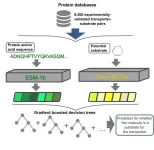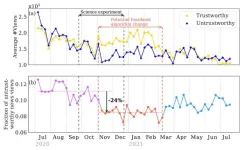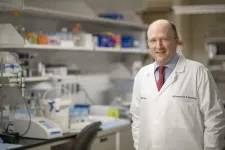(Press-News.org) Transport proteins are responsible for the ongoing movement of substrates into and out of a biological cell. However, it is difficult to determine which substrates a specific protein can transport. Bioinformaticians at Heinrich Heine University Düsseldorf (HHU) have developed a model – called SPOT – which can predict this with a high degree of accuracy using artificial intelligence (AI). They now present their approach, which can be used with arbitrary transport proteins, in the scientific journal PLOS Biology.
Substrates in biological cells need to be continuously transported inwards and outwards across the cell membrane to ensure the survival of the cells and enable them to perform their function. However, not all substrates that move through the body should be allowed to enter the cells. And some of these transport processes need to be controllable so that they only occur at a particular time or under specific conditions in order to trigger a cell function.
The role of these active and specialised transport channels is assumed by so-called transport proteins, or transporters for short, a wide variety of which are integrated into the cell membranes. A transport protein comprises a large number of individual amino acids, which together form a complex three-dimensional structure.
Each transporter is tailored to a specific molecule – the so-called substrate – or a small group of substrates. But which exactly? Researchers are constantly searching for matching transporter-substrate pairs.
Professor Dr Martin Lercher from the research group for Computational Cell Biology and corresponding author of a study, which has now been published in PLOS Biology: “Determining which substrates match which transporters experimentally is difficult. Even determining the three-dimensional structure of a transporter – from which it may be possible to identify the substrates – is a challenge, as the proteins become unstable as soon as they are isolated from the cell membrane.”
“We have chosen a different – AI-based – approach,” says Dr Alexander Kroll, lead author of the study and postdoc in the research group of Professor Lercher. “Our method – which is called SPOT – used more than 8,500 transporter-substrate pairs, which have already been experimentally validated, as a training dataset for a deep learning model.”
To enable a computer to process the transporter proteins and substrate molecules, the bioinformaticians in Düsseldorf first convert the protein sequences and substrate molecules into numerical vectors, which can be processed by AI models. After completion of the learning process, the vector for a new transporter and those for potentially suitable substrates can be entered into the AI system. The model then predicts how likely it is that certain substrates will match the transporter.
Kroll: “We have validated our trained model using an independent test dataset where we also already knew the transporter-substrate pairs. SPOT predicts with an accuracy above 92% whether an arbitrary molecule is a substrate for a specific transporter.”
SPOT thus suggests highly promising substrate candidates. “This enables us to limit the search scope for experimenters to a significant degree, which in turn speeds up the process of identifying which substrate is a definite match for a transporter in the laboratory,” says Professor Lercher, explaining the link between bioinformatic prediction and experimental verification.
Kroll adds: “And this applies for any arbitrary transport protein, not just for limited classes of similar proteins, as is the case in other approaches to date.”
There are various potential application areas for the model. Lercher: “In biotechnology, metabolic pathways can be modified to enable the manufacture of specific products such as biofuels. Or drugs can be tailored to transporters to facilitate their entry into precisely those cells in which they are meant to have an effect.”
Original publication:
Alexander Kroll, Nico Niebuhr, Gregory Butler, Martin J. Lercher. SPOT: a machine learning model that predicts specific substrates for transport proteins. PLOS Biology, 2024.
DOI: 10.1371/journal.pbio.3002807
END
Who transports what here?
Computer Science: Publication in PLOS Biology
2024-09-26
ELSE PRESS RELEASES FROM THIS DATE:
Fitness loss through spontaneous mutations will not impact viability of human populations in the near future
2024-09-26
Spontaneous mutations tend to reduce fitness in populations of living organisms, but this erosion of fitness is countered by natural selection. This study uses the first mutation accumulation experiment in a mammal to show that even in the absence of natural selection, the rate of fitness loss should not be of concern, which is reassuring for humans.
#####
In your coverage, please use this URL to provide access to the freely available paper in PLOS Biology: http://journals.plos.org/plosbiology/article?id=10.1371/journal.pbio.3002795
Article Title: An estimate of fitness ...
Prize recognizes discovery of how cell population protects our airways – and keeps them clear
2024-09-26
For uncovering how a cell population helps ensure food, liquid and acid reflux are kept out of our airway – and instead sent to our GI tract – Laura Seeholzer is the winner of the 2024 Eppendorf & Science Prize for Neurobiology. Her findings, detailed in April in Science, have motivated her to study what’s happening with these cells in diseases where this critical protective reflex is compromised.
“These findings are crucial for understanding potentially life-saving reflexes that are activated in the airway, ...
Team led by UMass Amherst debunks research showing Facebook’s news-feed algorithm curbs election misinformation
2024-09-26
AMHERST, Mass. – An interdisciplinary team of researchers led by the University of Massachusetts Amherst recently published work in the prestigious journal Science calling into question the conclusions of a widely reported study — published in Science in 2023 and funded by Meta — finding the social platform’s algorithms successfully filtered out untrustworthy news surrounding the 2020 election and were not major drivers of misinformation.
The UMass Amherst-led team’s work shows that the Meta-funded research was conducted during a short ...
Science publishes eLetter on 2023 study by Guess et al., as well as response by Guess et al.
2024-09-26
In 2023, Science published the study, “How do social media feed algorithms affect attitudes and behavior in an election campaign?” by Andrew Guess et al. Now, Chhandak Bagchi and colleagues – in an eLetter that will appear on the 2023 study – state that the study’s “reporting and conclusions did not account for a series of temporary emergency changes to Facebook’s news feed algorithm in the wake of the 2020 U.S. presidential election that were designed to diminish the spread of voter-fraud misinformation. This issue may have led readers to misinterpret ...
Supreme Court ruling could strip protections from up to 90 million acres of US wetlands
2024-09-26
New interpretations following the recent Sackett v. Environmental Protection Agency (EPA) United States Supreme Court ruling could strip federal protections from up to 90 million acres of U.S. nontidal wetlands – nearly all that exist in the coterminous US – according to a new study. The findings reveal the potential scope and impacts of the regulatory changes and highlight the uncertainty introduced by the ruling. Enacted in 1972, the Clean Water Act (CWA) aims to restore and protect the quality of U.S. waters ...
Ancient, buried wood inspires a possible low-cost method to store carbon
2024-09-26
Inspired by an ancient buried log, researchers present a novel method to remove and store atmospheric carbon for hundreds of years or more. It involves locking woody biomass away in “wood vaults.” The approach could provide a cost-effective solution to mitigate climate change. Achieving net-zero carbon dioxide (CO2) emissions is crucial for combating climate change, yet reducing fossil fuel emissions alone is insufficient to meet the Paris Agreement's targets. To achieve these goals, carbon dioxide removal (CDR) methods must be implemented, including engineering solutions, like direct air capture, ...
Removal of marine plastic fishery debris greatly reduces entanglement threat for endangered Hawaiian monk seals
2024-09-26
Large-scale removal of discarded fishing gear and other plastic debris from the waters of Northwestern Hawaii meaningfully reduced entanglement rates of endangered Hawaiian monk seals, according to a new study. The findings, which are drawn from more than four decades of data, offer promising evidence that marine debris cleanup programs are successful and that reducing plastic inputs and scaling up removal efforts could maximize conservation outcomes across marine ecosystems worldwide. Plastic pollution severely threatens marine ecosystems, ...
Climate change likely to increase diarrheal disease hospitalizations by 2100s
2024-09-26
By 2100, hospitalizations from diarrheal diseases are predicted to increase in the city of Dhaka in Bangladesh as a result of climate change, even if global warming stays under 2 degrees Celsius. Farhana Haque and colleagues from University College London, London School of Hygiene and Tropical Medicine and icddr,b report these findings in a new study published September 26 in the open access journal PLOS Neglected Tropical Diseases.
As one of the world’s most densely population cities, Dhaka deals with a high burden of diarrheal diseases. While some studies have looked at how weather affects diarrhea in Bangladesh, few have examined the future impact of climate ...
Cleveland Clinic researchers discover new bacterium that causes gut immunodeficiency
2024-09-26
September 26, 2024, Cleveland: Cleveland Clinic researchers have discovered a new bacterium that weakens the immune system in the gut, potentially contributing to certain inflammatory and infectious gut diseases.
The team identified the bacterium, Tomasiella immunophila (T. immunophila), which plays a key role in breaking down a crucial immune component of the gut’s multi-faceted protective immune barrier.
Identifying this bacterium is the first step to developing new treatments for a variety of inflammatory and infectious gut diseases. These conditions, including inflammatory ...
Research reveals impact of gut microbiome on hormone levels in mice
2024-09-26
Francis Crick Institute press release
Under strict embargo: 19:00hrs Thursday 26 September 2024
Peer reviewed
Experimental study
Animals
Researchers at the Francis Crick Institute have shown that the balance of bacteria in the gut can influence symptoms of hypopituitarism in mice.
They also showed that aspirin was able to improve hormone deficiency symptoms in mice with this condition.
People with mutations in a gene called Sox3 develop hypopituitarism, where the pituitary gland doesn’t ...
LAST 30 PRESS RELEASES:
Eye for trouble: Automated counting for chromosome issues under the microscope
The vast majority of US rivers lack any protections from human activities, new research finds
Ultrasound-responsive in situ antigen "nanocatchers" open a new paradigm for personalized tumor immunotherapy
Environmental “superbugs” in our rivers and soils: new one health review warns of growing antimicrobial resistance crisis
Triple threat in greenhouse farming: how heavy metals, microplastics, and antibiotic resistance genes unite to challenge sustainable food production
Earthworms turn manure into a powerful tool against antibiotic resistance
AI turns water into an early warning network for hidden biological pollutants
Hidden hotspots on “green” plastics: biodegradable and conventional plastics shape very different antibiotic resistance risks in river microbiomes
Engineered biochar enzyme system clears toxic phenolic acids and restores pepper seed germination in continuous cropping soils
Retail therapy fail? Online shopping linked to stress, says study
How well-meaning allies can increase stress for marginalized people
Commercially viable biomanufacturing: designer yeast turns sugar into lucrative chemical 3-HP
Control valve discovered in gut’s plumbing system
George Mason University leads phase 2 clinical trial for pill to help maintain weight loss after GLP-1s
Hop to it: research from Shedd Aquarium tracks conch movement to set new conservation guidance
Weight loss drugs and bariatric surgery improve the body’s fat ‘balance:’ study
The Age of Fishes began with mass death
TB harnesses part of immune defense system to cause infection
Important new source of oxidation in the atmosphere found
A tug-of-war explains a decades-old question about how bacteria swim
Strengthened immune defense against cancer
Engineering the development of the pancreas
The Journal of Nuclear Medicine ahead-of-print tip sheet: Jan. 9, 2026
Mount Sinai researchers help create largest immune cell atlas of bone marrow in multiple myeloma patients
Why it is so hard to get started on an unpleasant task: Scientists identify a “motivation brake”
Body composition changes after bariatric surgery or treatment with GLP-1 receptor agonists
Targeted regulation of abortion providers laws and pregnancies conceived through fertility treatment
Press registration is now open for the 2026 ACMG Annual Clinical Genetics Meeting
Understanding sex-based differences and the role of bone morphogenetic protein signaling in Alzheimer’s disease
Breakthrough in thin-film electrolytes pushes solid oxide fuel cells forward
[Press-News.org] Who transports what here?Computer Science: Publication in PLOS Biology


